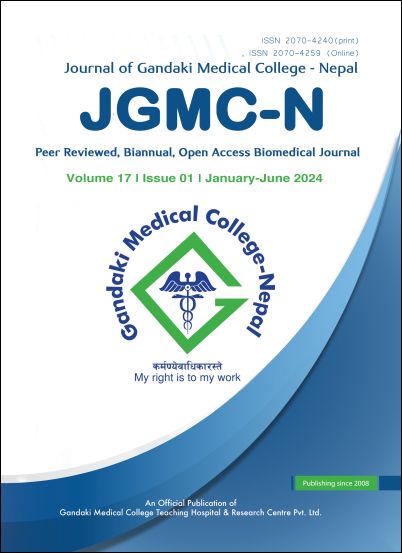Prevalence and outcomes of short birth spacing pregnancy: A cross-sectional study
DOI:
https://doi.org/10.3126/jgmcn.v17i1.62567Keywords:
Fetal outcomes, maternal outcomes, short birth spacingAbstract
Introduction: Short birth spacing pregnancies are associated with adverse maternal and fetal outcomes and are highly prevalent in Nepal. The study aimed to establish the prevalence of short birth spacing and observe maternal and neonatal outcomes in those pregnancies in Western Nepal.
Methods: A cross-sectional study was carried out among pregnant women aged 20 to 40 years, visiting Department of Obstetrics and Gynecology, Gandaki Medical College for a period of six months from April through October 2023. Data surrounding demographics, current and previous pregnancy and neonatal outcomes were collected in a structured questionnaire for women included into the short birth spacing group. Descriptive statistics were used to observe the outcomes.
Results: The prevalence of short birth spacing was 18.38%. The participants ranged from 21 to 37 years, mean age being 26.72 years. About half (52.5%) had an inter-delivery interval between 18 and 24 months. About a third women (34%) had fewer than four antenatal visits and over three-fourths (76.25%) of them delivered at term. Vaginal delivery was slightly more common than LSCS (52% vs 48%). Preterm and low as well as very low birth weight of babies were more frequently found in shorter interpregnancy interval group. Though 112(80%) neonates required intensive care service as a part of transitional care or due to sepsis, there were no neonatal deaths.
Conclusions: The prevalence of short birth spacing was comparatively less than the existing data from Nepal. The outcomes would have been better if the patients have frequent antenatal visits and are managed at tertiary care centers.
Downloads
Downloads
Published
How to Cite
Issue
Section
License
Copyright (c) 2024 The Author(s)

This work is licensed under a Creative Commons Attribution-NonCommercial 4.0 International License.
This license allows reusers to distribute, remix, adapt, and build upon the material in any medium or format for noncommercial purposes only, and only so long as attribution is given to the creator.




